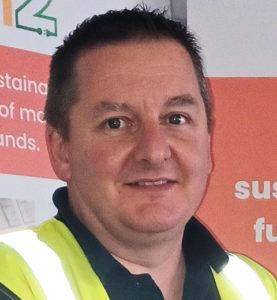Construction logistics: how do we scale up for net zero?
Ben Garner, low carbon logistics lead at Tarmac explains the company’s journey to net-zero.
When thinking about the journey to net zero construction in the UK, many people’s first thoughts are focused on cutting carbon in manufacturing and materials processes. While this will be integral, delivering a net zero industry will also require a fully decarbonised, multi-modal transport sector.
Achieving this goal calls for a cross-industry effort with support and leadership from central and local government. It requires new technologies and infrastructure, but also a greater appreciation of the importance of freight logistics to support essential industries like construction.
Low carbon improvements to our freight and logistics are already supporting Tarmac’s transition to net zero. Here are some reflections on industry progress to date, and some potential next steps for construction and the wider transport and infrastructure sectors to seize this opportunity.

Tackling the last mile
There’s already been a lot of progress made to tackle last mile logistics. This is in-part due to rapidly changing policy requiring logistics teams to be versatile enough to stay ahead of the curve, for example the emergence of ultra-low emissions zones (ULEZs) around the country. Today, 30 per cent of the UK population live in a town or a city with a low or zero emission zone.
Against this backdrop, last mile logistics has started to evolve through schemes such as the EV100, encouraging organisations to transition 100 per cent of their fleet to electric vehicles (EVs).
There are also technological initiatives taking place, such as the development of the UK’s first all-electric concrete mixer, which Tarmac has successfully rolled out for use in Birmingham. This is set to reduce up to 42 tonnes of CO2 annually as well as having zero tailpipe emissions – key attributes for delivering to urban centres.
Realising rail freight’s potential
Rail freight remains central to delivering a cleaner transport network and providing long-term value. The UK must not underestimate its importance to national construction. Transporting over 20 million tonnes of cement and aggregates across the sector every year, there has been an upward trend in rail freight use over the past decade.
Our own operations make us one of the largest private users of the UK rail network, so we are working hard to explore further options to decarbonise, like using low carbon fuels for locomotives. Hydrotreated vegetable oil (HVO) has been trialled for the delivery of materials along key strategic rail routes. Transitional fuels like this have the potential to lower our carbon footprint today, while we work to make zero emissions solutions viable at scale. HVO offers a reduction up to 90 per cent of a train’s carbon emissions compared to traditional red diesel.
Investment in wider infrastructure changes
It’s now well understood that meeting net zero will require the electrification of society, but a big challenge lies ahead in establishing the infrastructure to support it.
With EV battery technology approximately doubling vehicle range every two years, we can be confident these vehicles will meet our needs in the years ahead. What remains less clear, is when the infrastructure will be in place to charge all these new vehicles. The current system for establishing new connections is outdated, and the process of upgrading substations to cope with increasing demand takes too long. Dedicated public HGV charging facilities are essential, and yet there are none in the UK today.
Encourage behavioural change
Beyond the long-term net zero needs, there are opportunities that can be achieved in the short term to cut carbon emissions on a daily basis. Much of this can stem from basic behavioural change. For example, by installing smart telematics systems on vehicles, we are encouraging more energy efficient driving. By providing data to highlight rapid acceleration, heavy braking and idling engines, simple solutions like this could reduce fuel consumption by up to 10 per cent as we train drivers to become more carbon conscious.
Construction customers can help to decarbonise logistics too. Modern designs and safety standards addressing historic safety concerns mean there should be no barrier to using larger HGVs with 29 tonne payloads as standard. If customers could receive these higher capacity vehicles, around 30 per cent fewer journeys would be required overall.
Scaling up
Big challenges remain ahead to ensure we meet net zero targets, but construction logistics teams are building from a strong foundation of technological and behavioural changes. What’s needed now is to scale up delivery and establish an integrated low carbon logistics model to meet the needs of construction.
You can read more about Tarmac’s plans for net zero logistics here.








































































































